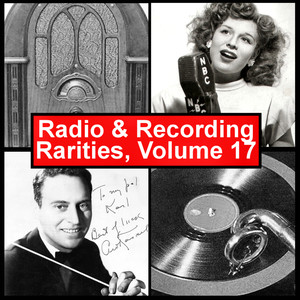
Radio & Recording Rarities, Volume 17
- 流派:Pop 流行
- 语种:英语
- 发行时间:2007-01-01
- 类型:录音室专辑
- 歌曲
- 时长
简介
BON BON and JAN SAVITT AND HIS TOP HATTERS: Jan Savitt (born Jacob Savetnick in Shumsk, Russia) was an American bandleader and violinist. He joined the Philadelphia Orchestra when he was only 19, having studied at The Curtis Institute and in Europe. His band, The Top Hatters, was formed in 1937 and began touring the following year. Savitt was one of the first Big Band leaders to feature an African American vocalist, George "Bon Bon" Tunnell. Other vocalists were Carlotta Dale, Allan DeWitt, Joe Martin, and Gloria DeHaven. Band names include Jan Savitt & His Top Hatters, the Jan Savitt String Orchestra and Jan Savitt & His Orchestra. CARMEN CAVALLARO: “Poet of the Piano”, Carmen Cavallaro showed a gift for music from age 3, picking out tunes on a toy piano. His parents encouraged the child’s talents and he studied classical piano in the U.S. In 1933, Cavallaro joined the Al Kavelin band, where he quickly became soloist. After four years, he switched to other big bands, including Rudy Vallee's in 1937. Starting his own five-piece combo in St. Louis in 1939, his group expanded into a 14-piece orchestra, releasing 19 albums for Decca. Although his band played all the top spots, he made a particular impact at the Mark Hopkins Hotel in San Francisco. Other venues where he drew devoted audiences included the Waldorf-Astoria, the Palmer House and the the Coconut Grove. Cavallaro developed a style of rippling arpeggios to augment his melody, which was arranged in thick and lush triple and quadruple octave chords. His musical interests included dance music, particularly Latin rhythms and tangos. HENRY BUSSE and MARION HOLMES: Henry Busse was born in Germany, emigrating to the U.S. in 1916 where he found work playing trumpet in a movie theatre pit band. He formed his own band and toured the country, ending up in San Francisco where they disbanded. In 1917 he was playing trumpet with the Frisco Jass Band and in 1918 he joined the Paul Whiteman Orchestra; Busse was a major contributor to Whiteman's Orchestra. He co-composed several of the band's early hit songs including "Hot Lips" and "Wang Wang Blues." Busse stayed with Whiteman until 1928 when he formed the Henry Busse Orchestra. This group, more a sweet dance than jazz band, had a successful career, continuing to record and perform until Busse's death in 1955. JIMMIE GRIER and RAY HENDRICKS: Jimmie Grier started his first band in 1932, where his first engagement was the Los Angeles' Cocoanut Grove. His tagline identified him as "The Musical Host of the Coast," meaning West Coast, even though he was nationally known because of periodic tours the Midwest and South. He was one of the busiest bandleaders in the Los Angeles area during the mid-1930s, playing nightly at the biltmore Bowl, writing and arranging for motion pictures and recording with his band and for Bing Crosby, the Boswell Sisters and others. In 1942, he volunteered for the military, entering the Coast Guard and becoming Rudy Vallee's assistant bandleader with the Coast Guard Band, eventually taking over that band until war's end. With bands declining in post-war years, he switched to a small combo, and eventually moved to being a disc jockey and then into real estate until he died in 1959. LOU BREEZE: Lou (b. 1900, d. 1969) began as a "Hot Jazz" musician in the 1920s under his own name, Lou Calabrese, working often with Paul Sprecht and His Orchestra. Later he led his Lou Breeze Orchestra, a popular band on the ballroom circuit that sometimes swelled to a monumental 90-piece ensemble. Among his Decca recordings are "Swamp Fire," "Humpty Dumpty Heart," and his signature tune, "Breeze Along With The Breeze."


![Dreamgirls (Music from the Motion Picture) [Deluxe Edition]](http://y.gtimg.cn/music/photo_new/T002R90x90M000000auXVr4DW8Qf.jpg?max_age=2592000)




